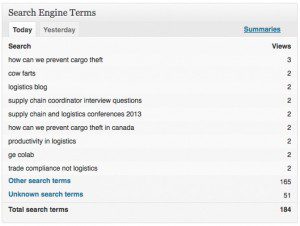On Tuesday morning I checked the reporting dashboard for Logistics Viewpoints. The screenshot below shows the search terms that were driving people to the blog that morning. The second item caught me by surprise; I thought only people interested in supply chain and logistics visited Logistics Viewpoints, but it seems like we attract a much broader and intellectually curious audience.
In other news this week…
- Globe Tracker International Launches Revolutionary, End-to-End Tracking, Monitoring and Trade Data Sharing for the Global Shipping Industry
- Freight Shipments Rose 1.2% in January from December
- Cass Truckload Linehaul Index
- Truckload Driver Turnover Slips in Fourth Quarter
- Retail Imports To Increase 2.3 Percent In March Despite ‘Sequestration’ Delays At Ports
- UPS Commits to Hire 25,000 Veterans
- Road funds on empty; more states weigh gasoline tax hikes (Reuters)
- U.S. Refiners Turn to Rail to Tap Canadian Oil (Wall Street Journal)
Globe Tracker International (GTI) introduced its Smart Autonomous Asset Solution that combines the company’s Trade Data Exchange Network (TDEN) and Smart Autonomous Asset Network (SAAN) with its Globe Tracker Communications Unit to enable “end-to-end tracking, monitoring, and trade data sharing for the global shipping industry.” Here are some details from the press release:
GTI’s Trade Data Exchange Network uniquely allows supply chain partners to securely and selectively share supply chain data from their own private databases, behind their own security firewalls. No one gives up control of their private data. Anyone of the partners can request the latest data for a particular asset, a parcel being shipped from China to Canada for example, through a secure web portal.
GTI’s Smart Autonomous Asset Network tracks and monitors assets for the purpose of improving the assets efficient utilization and as a by-product provide the asset owner with valuable real-time data that can be shared with its supply chain partners.
The centerpiece of GTI’s SAAN is the Globe Tracker Communications Unit (GTI Comm Unit) which is permanently installed on the asset. It will track and monitor for the life of the asset, truck trailers, dry bulk and reefer cargo containers, and railway cars for example.
I’ve never been briefed by Globe Tracker International, so I don’t know much about the company and its solutions. But I’m generally a proponent of network-based solutions for supply chain and logistics processes, assuming they are architected correctly. On the other hand, these types of asset-tracking networks have had mixed success in the past (see the shutdown of Savi Networks). Ultimately it comes down to this: Does the value of the asset and the data you’re collecting (and the benefits you can achieve by leveraging that data) justify the cost of the tracking hardware and service? Historically, the math worked out only for a handful of industries and use cases, but as the cost of the hardware continues to decrease, the market opportunities are arguably better today.
The Freight Transportation Services Index (TSI) increased 1.2 percent in January from December, rising for the third consecutive month. According to the press release:
The TSI increase in January likely resulted from inventory growth. Wholesale inventories grew 1.2 percent during the month, according to the U.S. Census Bureau’s Monthly Wholesale Trade report. The restocking followed the drawdown of inventories in the fourth quarter of 2012.
Freight shipments measured by the index were up 1.2 percent in January compared to the end of 2012. In comparison, the index declined 3.6 percent during the same period a year earlier in 2012.
In related news, according to the Cass Truckload Linehaul Index…
Truckload linehaul rates stayed steady from January to February, but have risen 4.3% since February of last year. From a trend perspective, truckload linehaul rates have risen or stayed flat almost every month since they bottomed out in 2010. Rates today are at their highest point in the most recent eight years (the dates included in our index). Despite that the steeper-than-normal cost increases in late 2012 were at least partially the result of increased demand in the Northeast post Superstorm Sandy, the higher rates are likely to hold in 2013, as supply and demand seem to be relatively balanced.
Somewhat contradicting these stats is the findings from the American Trucking Associations’ (ATA) Trucking Activity Report that “the turnover rate for drivers in the truckload sector took a surprising dip in the fourth quarter… the likely result of a weakened economy and overall freight volumes.” Here are some additional details from the press release:
Turnover at large truckload carriers dropped from an annualized rate of 104% in the third quarter to 90%, its lowest point since the first quarter of the year. For all of 2012, turnover averaged 98%, the highest since 2007 when the churn rate averaged 117%.
“As freight volumes slid a bit at the end of 2012, we saw turnover follow suit,” ATA Chief Economist Bob Costello said. “However, this is just a respite from the long-term trend and driver shortage storm that’s coming when the freight economy accelerates; and even then, these relaxed levels are still quite high relative to recent years.”
My overall takeaway is that trucking activity is a bit stronger today than a year ago, with the scales tilted slightly toward stronger growth in the weeks and months ahead depending on what happens with the economy.
Finally, UPS is following in the footsteps of Walmart, Con-way Truckload, and others in making a commitment to hire 25,000 veterans over the next five years. For related commentary, see “The Greatest Talent Pool Available – America’s Veterans.”
Have a great weekend!
Song of the Week: “Grey Cell Green” by Ned’s Atomic Dustbin










